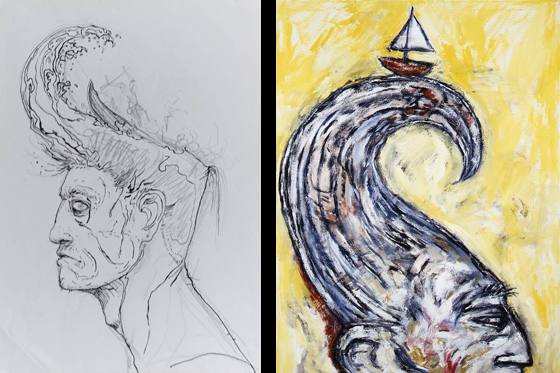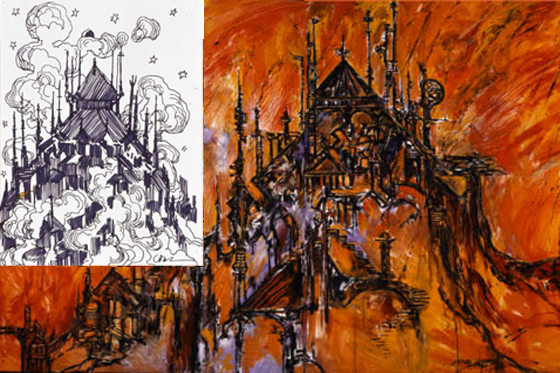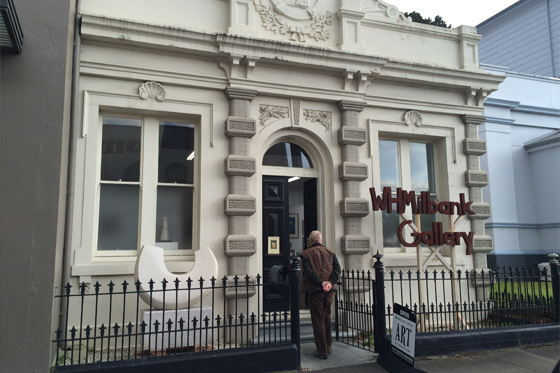When Sam Henderson walked into Fe29 and asked whether we would like to exhibit works by Clive Barker, we had to admit that we didn’t know who he was. That was until she mentioned Candyman and Hellraiser movies. Having spiked our interest, Sam proceeded to show us some of Barker’s paintings from the web. These works were certainly not what we had previously shown at Fe29, but it was obvious to us that Barker was indeed a very talented artist.
We searched the web further and found that, not only was Barker a talented film maker and artist, but also a poet, novelist, director, screenwriter and dramatist. Apparently his early creative journey began in Liverpool, England – he ran the Dog Company performing plays and theatre productions. He then moved into writing, drawing and painting. He has been described as a polymath in the same manner as the artist, director, and poet, Jean Cocteau.
We found the following quote from film director Quentin Tarantino where he sums up Clive Barker’s work as an author:
‘To call Clive Barker a horror novelist would be like calling the Beatles a garage band. Always creating and always pushing into the farthest reaches of the human mind, he is an artist in every sense of the word. He is the great imaginer of our time. He knows not only our greatest fears, but also (what) delights us, what turns us on, and what is truly holy in the world. Haunting, bizarre, beautiful. These are the words we can use to describe Clive Barker only until we invent new, more fitting adjectives.’
Apparently Sam and her partner (also in films) knew Barker, and had been in his home/studio in Hollywood on numerous occasions, even getting the opportunity to watch him working. Sam told us of 30 something works that she wanted to sell from her private collection, and we agreed to take a look.
It turns out that many of the works form the inspiration for paintings that later evolved, as well as fantastic illustrations for his fantasy novels of Abarat and Weaveworld. The images in this blog show some of these drawings alongside the finalised paintings.
Sam shares briefly a little of what she learned about Barker during her visits to his studio.
‘I first met Clive Barker in Los Angles in 2004 at his Hollywood hills home. Although best known as a successful novelist and filmmaker, Clive Barker has been creating paintings and drawings for over twenty years, but the man I met also had drank cups of British tea by the litre and had a sweet tooth requiring Tunnocks tea cakes and Kendal Mint Cake. I spent much time in Clive’s huge triple height studio, access only gained by a winding multi levelled staircase. The room was full of stacks of paintings, leaning up against one another. The easel area was surrounded by tubes of paint, some squirted onto paper plates, others used directly onto the canvases. Clive painted in a very physical manner, with huge large pieces needing him to move across the canvas. In creating his deeply expressive paintings, Barker brings to life the landscapes and figures that inhabit his mind. His colours are bold, paint application thickly layered, and surfaces often scratched or sanded, his tools were what ever he found at hand, including steak knifes and forks from his lunch plate.’
While we showed these works at Fe29 in 2016, we had not long been open and many people had not heard of the gallery. We decided that this years Fringe exhibition would be a good opportunity to exhibit them again alongside the works of a couple of other interesting artists – Marion Beaupère – a young French artist currently living in NZ – (also exhibited in 2016, not long after we opened), and Peter Bradburn (an itinerant Kiwi artist and poet) new to the gallery.
Enjoy!






















